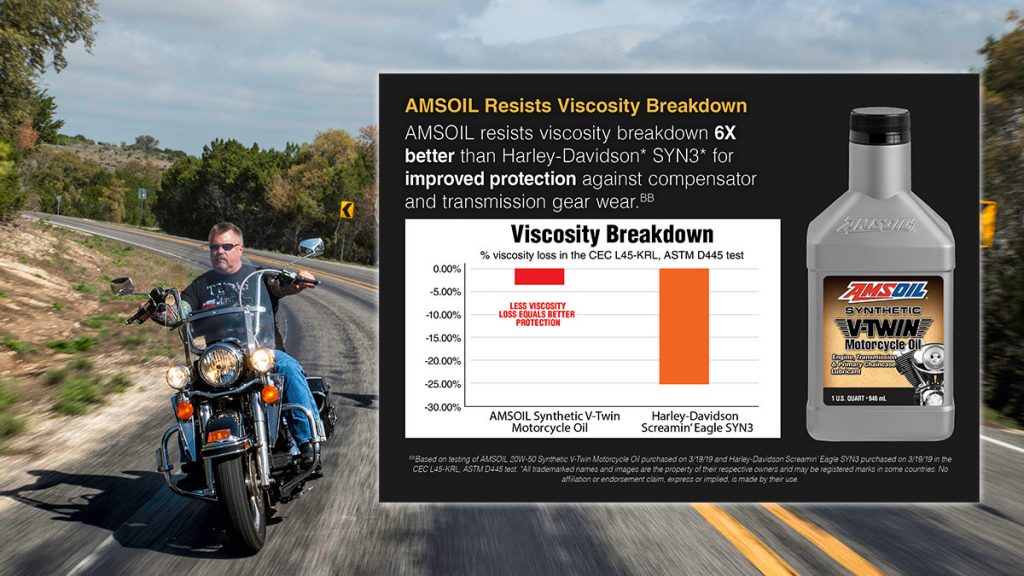Harley-Davidson* owners often ask how AMSOIL products compare to Harley-Davidson Screamin’ Eagle* branded lubricants, and that’s no surprise. Harley-Davidson has dominated motorcycle sales in America for a century, despite competition from brands like Indian* and Honda* in the cruiser and touring markets, and the recent growth in the adventure bike market spurred by BMW,* KTM,* Yamaha,* Honda and most other motorcycle manufacturers. In fact, Harley-Davidson recently introduced its own Pan America* ADV and LiveWire* electric bikes to stay competitive.
Like AMSOIL, the Motor Company is a great American success story, as William Harley and Arthur Davidson built their first motorcycle in a 10×15 shed 120 years ago, right here in our home state of Wisconsin. While the Milwaukee company’s original 116cc motorcycle lacked power by today’s standard, the brand has shaped American counterculture for more than a century. There’s a reason so many motorcyclists, including many AMSOIL employees, choose to ride Harleys.
Motorcycles destroy oil
Motorcycle engines, transmissions and primaries are hostile environments that take a toll on oil. Metal parts, including transmission gears, make contact thousands of times per minute, which can cause mechanical shearing of the oil’s structure that makes it thinner. Extreme engine heat also causes inferior oils to become thin, which is common in motorcycles.
Only a thin oil film protects transmission gears and bearings from wear, helps keep pistons from scuffing against cylinder walls, guards against compensator wear and more. Oil that’s too thin for the application doesn’t form a durable lubricating film on metal components, which reduces wear protection and can lead to noisy operation and premature engine and transmission wear.
There’s a good reason for typically higher recommended viscosities in motorcycle oils. Compared to cars, motorcycle engines often run hotter, at higher rpm, and the motor oil may perform double duty lubricating the transmission. A transmission oil film must be thick enough to cushion the gears against shock-loading, which reduces transmission noise and promotes smooth, quiet shifts.
Most Harley-Davidson motorcycles also have a compensator, which acts like a shock absorber to prevent engine vibration from reaching the transmission. Primary oil protects the compensator from wear that will cause it to make a ticking or knocking noise. Most bikers would rather enjoy the freedom of the open road than worry about their noisy compensator and how to fix it.
Viscosity matters
Viscosity is the most important property of motorcycle lubricants. While viscosity is defined as “resistance to flow,” it helps to think of it as the oil’s thickness. The higher the numbers, the thicker the oil, so a 20W-50 is thicker than a 5W-20 oil used in your truck. Motorcycle engines, transmissions and primaries are designed to use oil of a specific viscosity. For example, Harley-Davidson commonly recommends 20W-50.
The solution to thinning motorcycle oil is to use premium lubricants that maintain viscosity under heat and pressure to form a strong, protective film on metal parts, like AMSOIL Synthetic V-Twin Motorcycle Oil. Compared to Harley-Davidson Screamin’ Eagle SYN3* oil, AMSOIL is six times better at resisting viscosity breakdown for improved protection against compensator and transmission gear wear. Check out the test results for yourself.
While AMSOIL Synthetic V-Twin Motorcycle Oil is the perfect single oil for your Harley-Davidson engine, transmission, primary and chaincase. We also offer AMSOIL Synthetic V-Twin Primary Fluid and AMSOIL Synthetic V-Twin Transmission Fluid for those who prefer to fill each reservoir with a specifically labeled product.
Check out the full lineup of AMSOIL V-Twin motorcycle products, including complete oil change kits with everything you need in one convenient box! And if you own a metric motorcycle, dirt bike, or ATV/UTV, we have premium synthetic lubricants to protect those, too!
